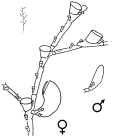WoRMS taxon details
Halopterididae Millard, 1962
22795 (urn:lsid:marinespecies.org:taxname:22795)
accepted
Family
- Genus Anarthroclada Naumov, 1955
- Genus Antennella Allman, 1877
- Genus Antennellopsis Jäderholm, 1896
- Genus Astrolabia Naumov, 1955
- Genus Calvinia Nutting, 1900
- Genus Cladoplumaria Ansin Agis, Ramil & Vervoort, 2004
- Genus Corhiza Millard, 1962
- Genus Diplopteroides Peña Cantero & Vervoort, 1999
- Genus Gattya Allman, 1885
- Genus Halopteris Allman, 1877
- Genus Monostaechas Allman, 1877
- Genus Monostaechoides Gil & Ramil, 2021
- Genus Nuditheca Nutting, 1900
- Genus Pentatheca Naumov, 1955
- Genus Polyplumaria Sars, 1874
- Genus Thamnopteros Galea, 2020
- Genus Acladia Marktanner-Turneretscher, 1890 accepted as Halopteris Allman, 1877 (synonym)
- Genus Diplopteron Allman, 1874 accepted as Polyplumaria Sars, 1874 (synonym)
- Genus Halicornaria Hincks, 1865 accepted as Halopteris Allman, 1877 (not in use)
- Genus Heteroplon Allman, 1883 accepted as Halopteris Allman, 1877 (synonym)
- Genus Paragattya Warren, 1908 accepted as Gattya Allman, 1885
- Genus Tetranema Fraser, 1937 accepted as Astrolabia Naumov, 1955 (invalid junior homonym of Tetranema Haeckel, 1879)
- Genus Thecocaulus Bale, 1915 accepted as Halopteris Allman, 1877 (synonym)
marine, fresh, terrestrial
recent only
Millard N.A.H. (1962). The Hydrozoa of the south and west coasts of South Africa. Part I. The Plumulariidae. <em>Annals of the South African Museum.</em> 46: 261-319., available online at https://www.biodiversitylibrary.org/page/40867077 [details]
Schuchert, P.; Choong, H.; Galea, H.; Hoeksema, B.; Lindsay, D.; Manko, M.; Pica, D. (2025). World Hydrozoa Database. Halopterididae Millard, 1962. Accessed through: World Register of Marine Species at: https://www.marinespecies.org/aphia.php?p=taxdetails&id=22795 on 2025-04-04
Date
action
by
2004-12-21 15:54:05Z
created
db_admin
![]() The webpage text is licensed under a Creative Commons
Attribution 4.0 License
The webpage text is licensed under a Creative Commons
Attribution 4.0 License
Nomenclature
original description
Millard N.A.H. (1962). The Hydrozoa of the south and west coasts of South Africa. Part I. The Plumulariidae. <em>Annals of the South African Museum.</em> 46: 261-319., available online at https://www.biodiversitylibrary.org/page/40867077 [details]
Taxonomy
redescription
Schuchert P. (1997). Review of the family Halopterididae (Hydrozoa, Cnidaria). <em>Zoologische Verhandelingen, Leiden.</em> 309: 1-162. [details] 
Other
 Present
Present  Inaccurate
Inaccurate  Introduced: alien
Introduced: alien  Containing type locality
Containing type locality
From editor or global species database
Diagnosis Plumularoidea forming colonies with erect cormoids arising either from creeping stolons, or from any strand of a polysiphonic stem formed by stolon-like tubes. Cormoid main axis bears hydrothecae, either simple or bearing hydrocladia in alternate or opposite positions. Cormoid main axis can be accompanied by stolon-like tubes. Hydrocladia either unbranched or branched. Hydrothecae with toothed or untoothed margin. Nematothecae of variable structure, one- or two chambered, movable or immovable, at least three associated with every hydrotheca, one or two inferior and one pair of laterals, nematothecae not fused to the hydrotheca, with the exception of the genus Antennellopsis in which the lateral nematothecae are partly fused to the hydrotheca. Gonophores as fixed sporosacs contained in gonotheca. Gonothecae arising from caulus or hydrocladia, never protected by hydrocladia or modified hydrocladia, not aggregated, usually dimorphic and with at least the female normally bearing nematothecae. [details]

